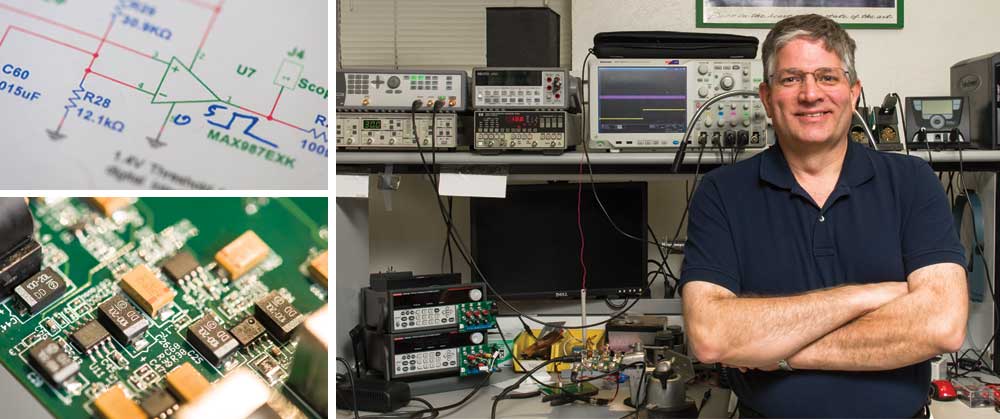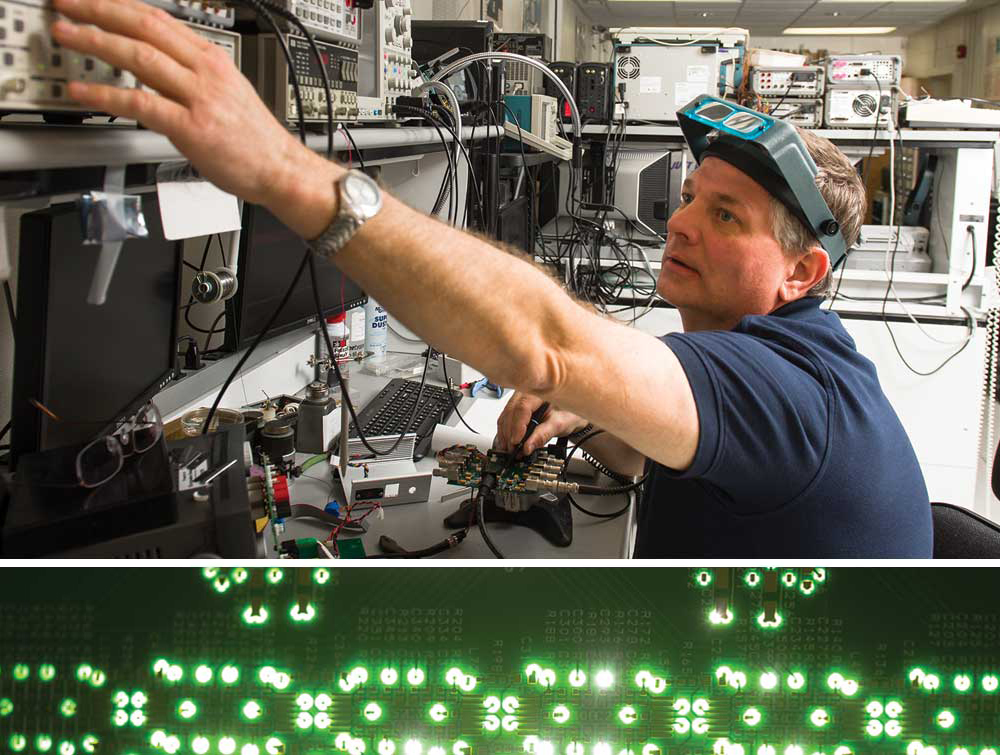In-house laboratory turns ideas into products
By Greg Tammen
It's easy to think of the Electronics Design Laboratory at Kansas State University as an in-house MacGyver. The lab's production design engineers can seemingly build and modify anything.
During its 19 years of operation, the laboratory has developed everything from components used to create particle acceleration in CERN's Large Hadron Collider to devices that heat cows' ears, all to develop monitoring that improves livestock health in large-scale feedlots.
Timothy Sobering, laboratory director, oversees a team of production design engineers that include Russell Taylor, electrical engineer; David Huddleston, technician; and four student interns. The lab specializes in circuitry, software, commercial equipment and data acquisition systems. It uses these skills to develop electronics for the university and industry, which in turn help Kansas businesses and the state's economy.
"Our philosophy is whatever somebody wants, we'll find a way to buy it, build it, borrow it or modify it to fit the client's needs," Sobering said. "The nature of research is that you're doing something new and different, so it's unlikely that you're going to be able to buy a piece of equipment that does exactly what you need it to. You may need something in between your research and what's commercially available. That's where we come in."
Of its more than 400 projects, here are some of the labs successes with Kansas entrepreneurs:
- A digital braking system for large trailers that is safer than the currently used pendulum braking systems.
- An ultrasonic device that prevents insect repopulation in grain bins.
- A redesigned probe that measures the moisture in dried foods and bulk solids to increase quality control.

Recently, the Lawrence-based company Avatekh Inc. partnered with the lab, which is priming the Kansas company's products for the commercial market. The lab is helping Avatekh develop technology and hardware algorithms to make smartphones run faster and with improved battery life. A Phase 1 Small Business Innovation Research grant from the National Science Foundation is funding the collaboration.
Bill Kuhn, professor of electrical and computer engineering, is working with the lab to produce various circuit boards for his NASA EPSCoR project, which seeks to develop wireless wearable physiological sensors for spacesuits as well as low-power devices that monitor astronauts' health.
The lab also is beginning a multimillion project with faculty in high-energy physics to develop new equipment that will help scientists at the Fermi National Accelerator Laboratory, or Fermilab, conduct experiments.
The following are among some of the clientele and collaborations of the lab:
- Honeywell Federal Manufacturing and Technology.
- Sandia National Laboratories.
- University of Kansas.
- University of Missouri, Kansas City.
- University of Tennessee.
- Advanced Manufacturing Institute at Kansas State University.
- Developing radiation detectors for the Semiconductor Materials and Radiological Technologies, or SMART, Laboratory at Kansas State University.
- Multiple longstanding working relationships with faculty in the departments of mechanical engineering, nuclear engineering, electrical and computer engineering, and high-energy physics at the university.

In addition to its work with researchers and industry, the lab is an incubator for young talent. Student engineers selected to intern in the lab are frequently fast-tracked in their education, as the students work alongside professional engineers to develop hardware that fits the clients' needs.
"I've had classes where the professor will introduce something new and I remember doing that six months ago in the lab," said Jake Sobering, a senior in electrical and computer engineering whose first project involved modifying a Nike+ FuelBand to see if it could be adapted to monitor radiation levels rather than exercise performance. "I want to go into the fields of either bio- and neuroprosthetics or robotics. I need to be skilled for those, and I feel like I've been learning those skills and confidence since day one."
•••
Extracurricular education
Electronics Club is a student-run organization where members use their own money and free time to design and build anything they can imagine. Among those ideas are an automated air hockey table with a robot opponent; a HDMI adapter that uses LEDs to create ambient backlighting to compliment what's on the TV screen; and sword-fighting robots.
The club is another venue for students to gain practical, hands-on experience, said Timothy Sobering, director of the Electronics Design Laboratory and a faculty adviser to the club.
"The idea is to target freshmen coming in so they can build something and show people what they built," Sobering said. "As they learn to build something, they start asking questions about what they built, such as what this microchip does and how the product can be modified to work better or do something different. You end up with some students who are really engaged and involved in what they're doing."
